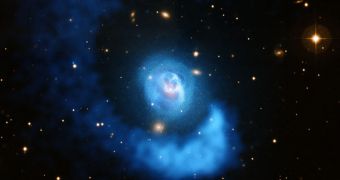Using data from a number of telescopes, experts were recently able to snap a new view of the galaxy cluster Abell 2052. The formation is of interest because the massive gas clouds it contains display a sloshing-like motion, similar to how a liquid wobbles inside a glass when moved.
Investigators used visible-light data captured by the European Southern Observatory's (ESO) Very Large Telescope (VLT), at Cerro Paranal, Chile. These wavelengths are represented in gold. The blue hues represent data from the NASA Chandra X-ray Observatory.
The reason why Chandra sees this structure so vividly is that the motion of the gas clouds within the cluster is heating up the material, causing it to emit strongly in the X-ray portion of the electromagnetic spectrum. The gas produces vast amounts of bright radiations, which the NASA telescope can detect.
According to scientists, gas is heated up to temperatures reaching 30 million degrees. The clouds are not static inside the central elliptical galaxy of the Abell 2052 system. At the same time, they also form a 1-million-light-year-long, spiral-like structure around the central galaxy.
One of the possible explanations for this spiral is that a cluster of smaller galaxies collided with this cluster long ago. The tidal effects would have disintegrated the smaller galaxies, forcing them on a circular path around the more massive formation.
The sloshing motion of the gas within the central cluster is caused by that fact that dense, hot gas clouds in the smaller clusters zipped right through its core, before finally yielding to gravity. This pulled it backwards towards the center, but the gas again moved to far away.
The motion is best likened to how wine moves from side to side in a glass, after the glass has been jerked sideways. This is happening in Abell 2052, but at a monumental scale and over millions of years.
Due to the extreme heat within the central portions of the cluster, stellar formation is significantly impaired, astronomers propose. Previous studies have demonstrated that stellar nurseries need cold molecular hydrogen gas in order to give birth to blue stars.
An additional mechanism that prevents gas from cooling down is represented by radiation jets produced within the central, supermassive black hole powering up the cluster. The object is constantly blasting surrounding gas clouds with radiations, maintaining it warm.
Abel 2052 is located relatively near-by, at a distance of just 480 million light-years. This is relatively near in astronomical terms, and allows experts to study it in detail.

 14 DAY TRIAL //
14 DAY TRIAL //